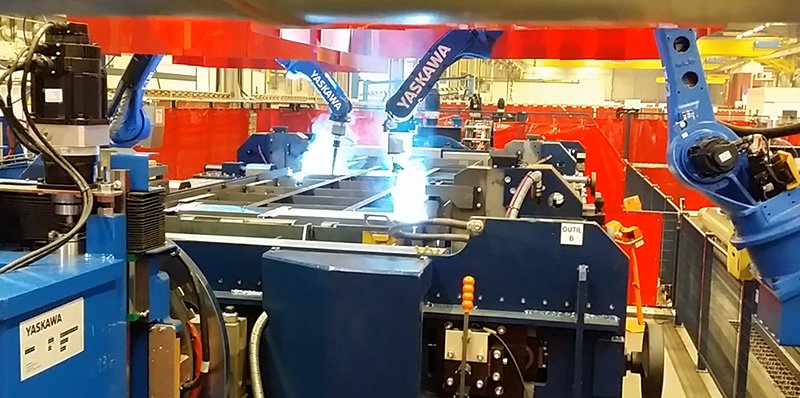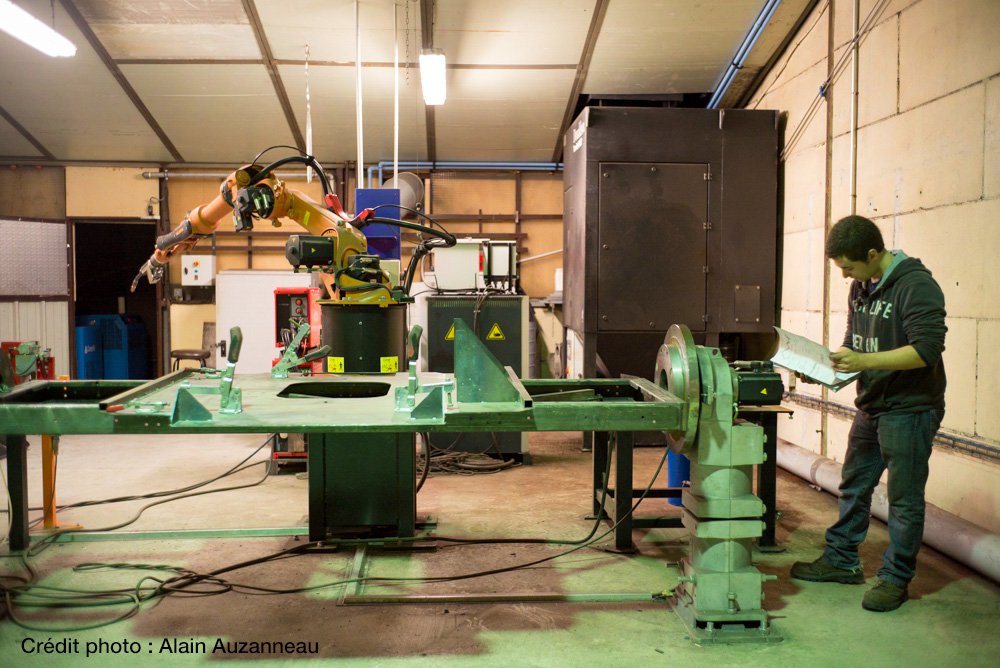Off-line programming of arc welding robots with Almacam Weld
Off-line programming of welding robots is a useful alternative to programming by learning. But implementation of this programming method cannot be improvised. With more than 20 years of experience in developing off-line programming software, Alma proposes a high added value technical solution and a proven deployment methodology, essential for your project to succeed.
The technological process
Arc welding is a process of assembling metal parts that appeared at the end of the 19th century. An electric current melts and fuses a filler metal to the base material of the parts to be assembled. By cooling, the metal bath forms the joint that unites the parts.
Robots are used increasingly to perform welding operations, particularly to compensate for the lack of professional welders. These 6-axis robots can be combined with positioners or rotating tables on which the parts to welded are mounted. A cell can comprise several work stations, several robots working together.
There are many areas of application for robotic welding: ship-building, automobile industry, agricultural machinery, metal furniture and frameworks, building services, boiler-making, etc.
Despite considerable investments, there are many advantages of robotic welding:
- Constant quality and precision of welding,
- Increased productivity,
- Flexible production,
- Automation of difficult or dangerous tasks,
- Remedy for lack of experienced welders, etc.

Off-line programming of arc welding robots: a solution for the future
Off-line programming of welding robots is a useful alternative to programming by learning. Industrial companies, including SMIs, are increasingly integrating off-line programming, and can easily measure the advantages of this solution:
- Maximizing productive use of the robot through programming in hidden time;
- Reduction of programming costs;
- Anticipation on programming of the cell and validation of the tooling;
- Improvement in welding quality;
- Better working conditions;
- Increased operator safety, etc.
The flexibility offered by off-line programming is particularly useful when the manufactured products are varied, adaptable, or required to undergo frequent changes and when the production series are small.
To successfully implement off-line programming a number of prerequisites do have to be fulfilled, because this approach has repercussions on the whole of the design and manufacturing process. It is therefore preferable to integrate it as soon as the robotization project begins and to start it up at the same time as the robotized cell. It is important to give yourself enough time and human resources to integrate the robotized process and off-line programming. It is also important to envisage in-depth training for future users of the robotics system software. The “motivation” factor should not be neglected, as these users will usually be required to take on ownership of a completely new tool.
Finally, mechanical calibration of the robot cell and software calibration (update of the virtual in relation to the real cell) are two decisive steps for the productivity of off-line programming.
Advantages of the Alma off-line programming solution (OLP)
Although the comparisons of times for off-line programming and programming by learning vary depending on the type and complexity of the parts to weld, we can nevertheless estimate that Alma’s Almacam Weld off-line programming is 2 to 10 times faster than programming by learning, and this is without taking account of the time saved by not immobilizing the robot.
In addition to the benefits of off-line programming indicated above, the Alma solution has several advantages. It:
- Eliminates adjustments on the robot by means of precise software calibration, combined with rigorous mechanical calibration of the cell and use of sensing;
- Automates the programming process thanks to programs that duplicate programs for similar assemblies with different dimensions;
- Gains programming time thanks to an ergonomic interface and advanced automation functions;
- Can be adapted to any brand of robot and any configuration for robotized arc welding.
In addition, with Alma, calibration, start-up, training and support are provided by a highly experienced team, devoted to its customers.
Robots we drive
Testimonial

I’m sure that robotic welding has a great future. We need to get on board right now, because if we don’t switch over to robotics today, in five years time we will disappear… The more complex the parts are, the more off-line programming is necessary. And to obtain flexibility in robotic welding, it’s absolutely vital. The Alma software makes programming easy and fast. It represents roughly one hour per program, whereas on the robot you would need a day, not counting the robot immobilization time.
Nicolas Froment, Head of MétalFormage